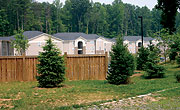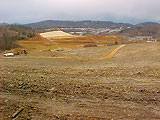
When the city goofs: Newly planted trees fill in for a mature woods that once screened the Campus Crest development from nearby residences — woods that were cut down because, as Planning Director Scott Shuford put it, he didn’t do “a very good job of communicating that.” photo by Cecil Bothwell.
|
In a sense, Asheville’s Unified Development Ordinance leaves very little to the imagination. In some instances, however, UDO regulations are intended only to provide a basis for staff to interpret the document. And because no law can cover all the unique situations that may come up, the UDO allows itself to be overruled in various ways by the Board of Adjustment, via actions called variances. The board can elect to grant requested variances on a case-by-case basis — as can City Council. But no other local board or bureaucrat is legally empowered to vary from or alter the rules.
Nevertheless, in recent years, city staffers have allowed developers to act in apparent violation of the UDO on a number of projects. A recent analysis of Asheville’s UDO enforcement by professor David Owens of the School of Government at UNC-Chapel Hill identified a number of such violations (see below). No variance was granted in any of these cases, and most of the violations have not been corrected as mandated by city ordinances. This raises the possibility that developers seeking to avoid various UDO requirements could cite these failures to enforce as a defense against having to comply with them.
Commercial signs
• Staples on Merrimon Avenue: Four signs appear to exceed the size limits, based on this reporter’s review of the blueprints. However, the School of Government report concluded that the ordinance itself is ambiguous and urged City Council to clarify its intent.
“This is a close call and could go either way,” Owens wrote. “If one accepts the premise that the red rectangular background is part of the Staples logo and is viewed by the public and the owner as an integral part of the sign … it would be permissible to calculate the larger red rectangle … [as constituting the sign’s size].” Staples’ use of the full background in its advertising supports consideration of the whole as a corporate logo, which would make the signs larger than allowed, critics have pointed out.
• Prudential Realty on College Place: One sign exceeds the size limit. Former Director of Development Services Joe Heard sent a letter advising Prudential of the violation on March 15, acknowledging that the situation resulted from an error by his staff. Planning & Development Director Scott Shuford has admitted the city’s enforcement error and said he has no plans to demand compliance. (See “What the Mama Saw, It was Against the Law,” May 17 Xpress.)
UDO fine print: Sign Regulation Sec. 7-13-4(1)a says: “The area of a sign [includes] … all lettering, wording design or symbols, together with any background … and any illuminated part of the sign.”
Plantings and buffers

Down on the Wal-Mart farm: Shuford ruled that clear-cutting of trees on the Sayles-Biltmore Bleachery site was an unregulated agricultural project – despite UDO rules that require permits for “land disturbing activity … including cutting and removal of trees.” photo by Brian Sarzynski
|
• Campus Crest in Montford: Preserving a wooded buffer area between the Campus Crest development and adjacent residential property was supposed to be a condition of the building permit, agreed to by the developer and approved by City Council during a formal hearing. Planning Director Shuford later admitted that he’d failed to include that condition in the written version of the permit. The outcome: the loss of a row of mature trees as a buffer along the edge of the development, and no action by the city (see “Nothing but the Truth,” Jan. 19, 2005 Xpress).
• Former Burger King site on Merrimon Avenue: Preserving a wooded buffer strip and an adjacent stand of trees was a condition of developing the site. After cutting and bulldozing the woods, the developer was temporarily made to stop work; no fine was imposed. Staff cited a paperwork error on the city’s part that led to confusion about whether the trees had to be saved.
• Wal-Mart at the former Sayles-Biltmore Bleacheries site in east Asheville: Preserving a wooded river frontage was a condition of the permit. The developer cut and bulldozed the area and was not fined, though the city did request $5,600 to pay for replacing the trees. Shuford recently told Xpress that the city had collected $2,800 in this case.
Grandfathered uses
The UDO contains grandfather provisions allowing older structures that don’t meet currrent code to continue to be used. But the law also says that if such structures are significantly modified or improved, they must be brought up to current code, unless the Board of Adjustment grants a variance.
• Greenlife Grocery on Merrimon Avenue: The developer was permitted to modify and expand a grandfathered loading dock without bringing it up to current code or obtaining a variance. The dock’s configuration forces some commercial traffic to use Maxwell Street, in violation of (1) a UDO stipulation that commercial properties fronting on commercial streets not use adjacent residential streets for access, and (2) a UDO requirement that nonconforming structures not used for more than 180 days be brought into compliance. Owens, however, went one step further in his analysis, saying that once additions were made to the building, it could no longer be grandfathered.
UDO fine print: The grandfather rule, which applies to structures built before the ordinance was adopted, limits the expansion of grandfathered structures as follows: “Sec. 7-13-4(b)(1) Any improvement or expansion of any [nonconforming] structure … must comply with all other minimum requirements of this chapter or a variance must be obtained.”
Driveway width
The UDO spells out explicit limits on driveway width that can be exceeded only with permission from the Board of Adjustment. Greenlife’s driveway openings on both Merrimon Avenue and Maxwell Street exceed the 36-foot statutory limit (the Merrimon opening is 75 feet wide; the Maxwell opening is more than 50 feet). No variance has been approved. Owens concluded that the driveway openings violate the UDO width limit.
UDO fine print: “Sec. 7-11-1 (g) Access point requirements. The following standards shall be met when designing vehicular access points from public streets to individual properties, excluding single and two-family residential: (1) Width of access points. Two-way [driveway] Minimum 24 feet (with proper radius) Maximum 36 feet.”
Visibility triangles and other issues
The UDO includes detailed requirements for “sight triangles” at driveway openings and intersections, to ensure that drivers have a clear view of oncoming traffic as they enter and exit the property in question.
• Staples: Based on this reporter’s observation, the development appears to violate a prohibition on placing structures within a defined traffic-visibility triangle at intersections. The building should be at least 10 feet from the Merrimon sidewalk; in fact, it is only about two feet from the sidewalk. Notes and letters exchanged during the permitting process — before construction began — indicate that at least one city staffer was aware that the site plan was in violation, but the error was cast in concrete anyway.
City Manager Gary Jackson told Xpress: “As for the sight-triangle example, it was determined by staff as meeting the requirement for a 10-foot-by-50-foot triangle. The opinion was that sight triangles are to be measured from the property line generally, but given that Merrimon cannot practically be widened in this direction, the curb line is the more appropriate basis for the application.”
However, there is no language in the UDO permitting staff to arbitrarily choose a new starting point for measurement of a sight triangle. The School of Government analysis concluded that the ordinance does not support staff’s decision, stating, “The staff must apply the rule as written.”
The analysis also questions whether the Staples building really qualifies as pedestrian-friendly, as staff had concluded. That conclusion led the city to waive the UDO’s setback requirement, which would have placed the building 15 feet from the right of way. But Owens noted, “The plan in many respects reflects more of an automobile oriented business.”
• Greenlife: Concerning the grocery’s loading-dock area, Owens found that routinely parking trucks within a sight triangle violates the requirements.
UDO fine print: “Sec. 7-11-1. Parking, loading, and access standards.(h) Sight visibility triangles at street intersections. (1) Sight visibility triangle required. In order to ensure visibility at intersections, sight visibility triangles shall be maintained at all intersections of public streets, private streets, and driveway access points.” The law spells out specific dimensions based on the type of intersection involved.
Penalties
Almost all violations of the UDO are subject to penalties, as spelled out in the ordinance.
UDO fine print: ” Sec. 7-18-2. Penalties for violations. (b) Civil penalties. (1) General. Violations of this chapter, except violations of section 7-5-13, and 7-12-2 and Articles XIII and XV, shall subject the offender to a penalty in the amount of $100.00 per day for each day the violation continues, to be recovered by the city in a civil action in the nature of debt if the offender does not pay the penalty within the prescribed period of time after he or she has been cited for the violation.
… (d) Each day a separate violation. Except as indicated in subsection 7-18-29(b)(3) above, each day that a violation continues shall constitute a separate and distinct violation or offense.”
It would appear that the city could and should be collecting a substantial amount of money in fines for violations. Shuford told Xpress that numerous fines have been levied and paid in recent years. But various city departments contacted were unable provide details of collection amounts or procedures.



Before you comment
The comments section is here to provide a platform for civil dialogue on the issues we face together as a local community. Xpress is committed to offering this platform for all voices, but when the tone of the discussion gets nasty or strays off topic, we believe many people choose not to participate. Xpress editors are determined to moderate comments to ensure a constructive interchange is maintained. All comments judged not to be in keeping with the spirit of civil discourse will be removed and repeat violators will be banned. See here for our terms of service. Thank you for being part of this effort to promote respectful discussion.